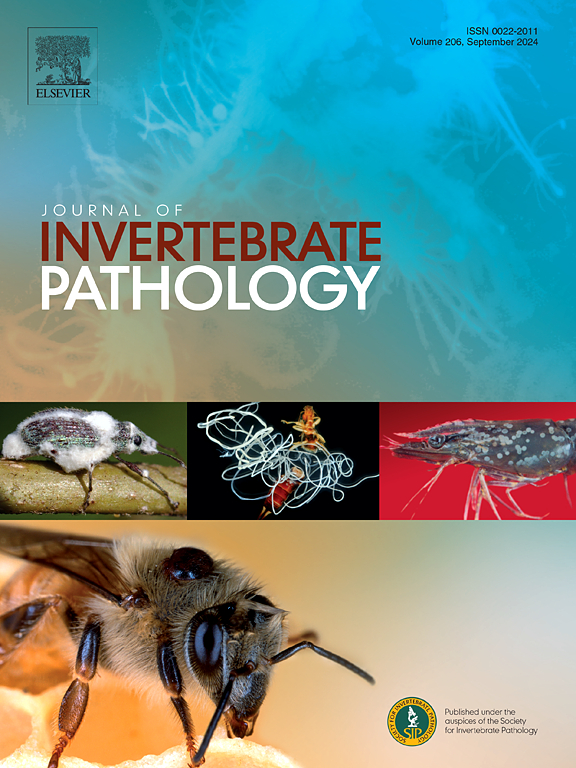Occurrence and allele frequencies of genetic variants associated with Varroa drone brood resistance (DBR) in African Apis mellifera subspecies
IF 3.6
3区 生物学
Q1 ZOOLOGY
引用次数: 0
Abstract
The ectoparasite Varroa destructor is a major contributor to the global decline of honeybee colonies (Apis mellifera), especially in the Northern Hemisphere. However, Varroa-resistant honeybee populations have been reported in various regions around the globe, including Europe and Africa. This resistance is primarily attributed to the trait known as Suppressed Mite Reproduction (SMR), which significantly reduces the reproductive success of Varroa mites within these colonies. Although this trait is still poorly understood, several efforts have been made to unravel the genetic basis of SMR. For example, a study in Belgium determined eight genetic variants in the honeybee genome that are associated with the infertility of mites in drone brood (Drone Brood Resistance or DBR). As these eight variants were found and validated in subpopulations of European subspecies only, there is limited knowledge about the occurrence of these markers in African honeybees. Hence, this study was designed to determine the allele frequencies of these eight genetic variants in African honeybee populations. More specifically, we used qPCR assays with dual-labeled probes to analyze bee samples collected from Benin, Ethiopia, and Uganda. Our results showed the presence of seven of the eight variants in African Apis mellifera subspecies, which may contribute to their innate resistance against the Varroa mite. Moreover, we found significant differences in allele frequencies among the three sampled African bee populations, suggesting the presence of genetic diversity within these populations, potentially altering their resistance to Varroa. This study revealed similar allele frequencies between African honeybees and bee samples from the European iberiensis-subspecies (A lineage), while Ethiopian bees showed distinct distributions, indicative of a unique lineage. Overall, the occurrence of most DBR-associated genetic variants in African honeybees opens research opportunities to elucidate the predictive properties and potential of these genetic variants in the African continent by examining genotype-phenotype associations.

非洲蜜蜂亚种雄蜂抗性遗传变异的发生及等位基因频率
外寄生瓦螨是全球蜜蜂种群(Apis mellifera)减少的主要原因,特别是在北半球。然而,在包括欧洲和非洲在内的全球各个地区都报道了抗瓦螨的蜜蜂种群。这种抗性主要归因于被称为抑制螨繁殖(SMR)的性状,这显著降低了这些种群中瓦螨的繁殖成功率。虽然这一特性仍然知之甚少,但已经做出了一些努力来揭示SMR的遗传基础。例如,比利时的一项研究确定了蜜蜂基因组中的8种遗传变异,这些变异与蜂群中螨虫的不育有关(蜂群抗性或DBR)。由于这八种变异仅在欧洲亚种的亚种群中被发现和验证,因此对这些标记在非洲蜜蜂中的发生的了解有限。因此,本研究旨在确定非洲蜜蜂种群中这8种遗传变异的等位基因频率。更具体地说,我们使用双标记探针的qPCR分析了来自贝宁、埃塞俄比亚和乌干达的蜜蜂样本。我们的研究结果表明,在非洲蜜蜂亚种中存在8种变异中的7种,这可能有助于它们对瓦螨的先天抗性。此外,我们发现在三个取样的非洲蜜蜂种群中等位基因频率存在显著差异,这表明这些种群中存在遗传多样性,可能会改变它们对瓦罗阿的抗性。该研究揭示了非洲蜜蜂和来自欧洲伊比利亚亚种(A谱系)的蜜蜂样本之间相似的等位基因频率,而埃塞俄比亚蜜蜂显示出不同的分布,表明一个独特的谱系。总的来说,非洲蜜蜂中大多数与dbr相关的遗传变异的发生为通过检查基因型-表型关联来阐明这些遗传变异在非洲大陆的预测特性和潜力提供了研究机会。
本文章由计算机程序翻译,如有差异,请以英文原文为准。
求助全文
约1分钟内获得全文
求助全文
来源期刊
CiteScore
6.10
自引率
5.90%
发文量
94
审稿时长
1 months
期刊介绍:
The Journal of Invertebrate Pathology presents original research articles and notes on the induction and pathogenesis of diseases of invertebrates, including the suppression of diseases in beneficial species, and the use of diseases in controlling undesirable species. In addition, the journal publishes the results of physiological, morphological, genetic, immunological and ecological studies as related to the etiologic agents of diseases of invertebrates.
The Journal of Invertebrate Pathology is the adopted journal of the Society for Invertebrate Pathology, and is available to SIP members at a special reduced price.

 求助内容:
求助内容: 应助结果提醒方式:
应助结果提醒方式:


